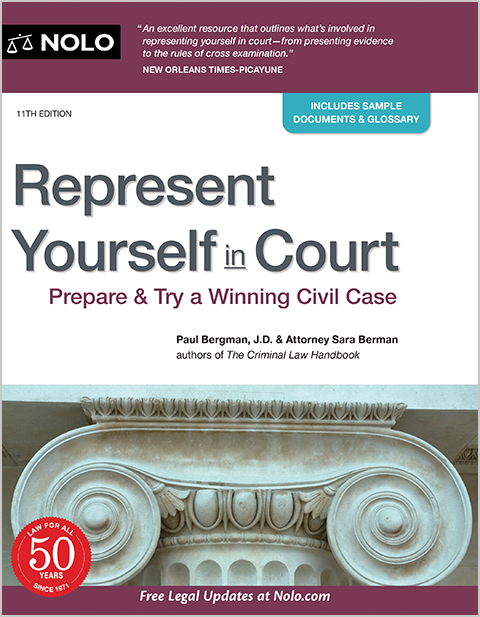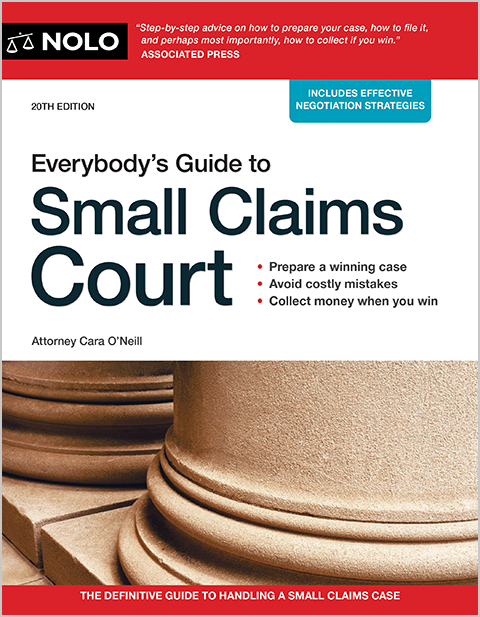Find why it's important to put the terms of a small claims court settlement agreement in writing.
Reducing a settlement to writing in a legal dispute is essential regardless of whether it's a superior court or small claims court settlement agreement. Whenever you and the opposing party in a dispute agree to settle a case on your own or with the help of a mediator, you'll want to promptly write it down to prevent future issues.
It also doesn't matter whether you and your opponent negotiate your settlement or reach it with a mediator's help. In either case, you'll want to ensure it's reduced to writing and signed before agreeing to dismiss the lawsuit.
What Is a Settlement Agreement and Release?
Lawyers call an agreement to settle a dispute a "release" because one person gives up (or releases) his or her claim against another in exchange for some act, usually the payment of money.
For instance, if the paint on John's building is damaged when Sandra, a neighboring property owner, spray-paints her building on a windy day, John might agree to release Sandra from liability and not pursue her legally if she agrees to pay $2,000 to have the damaged area of John's building repainted.
If a court action hadn't yet been initiated, a signed settlement agreement and release given in exchange for payment of the agreed funds would be all that would be needed. If a lawsuit had already been filed, the exchange of the signed settlement and payment should occur before the lawsuit is dismissed.
When Is a Written Settlement Agreement and Release Valid?
A written settlement agreement and release is valid if it is signed by both parties, fair, in the sense that neither party was tricked into signing based on misrepresentation, and provides each party with some benefit (e.g., if you pay me $500, I won't sue you, and I'll keep my dog out of your yard).
If either party later violates the settlement terms, the other can file a lawsuit and receive a court judgment for appropriate damages.
Consequences of Signing a Written Settlement Agreement or Release
It's important to understand that settlement agreements are powerful legal documents. If you completely release someone who damaged your car for $500, only to later find out that the damage was more extensive, you'll be stuck with the $500 unless you can convincingly claim that the other party was guilty of misrepresentation or fraud in getting you to sign the settlement agreement.
Of course, in most situations where the details of a dispute are well known, a settlement can be comfortably signed with the knowledge that the dispute will finally be laid to rest.
Settlement Release Types
There are different types of releases for different situations. You might want a general or specialized release that can be used for auto accidents, property damage, and personal injuries. There are also mutual release forms for use when both parties give up claims.
Any release you use should contain the following information:
- The names and addresses of the party being released (the potential defendant) and the party granting the release (the potential plaintiff).
- A brief description of the "what," "when," and "where" of the dispute or issue to which the release pertains. (The release below provides several blank lines for you to briefly describe the events giving rise to the need for the release.)
- A statement of what the person giving up a claim is getting in return. As mentioned, for a release to be a valid and enforceable contract, the person signing the release (releasor) must receive something of benefit (called "consideration" by lawyers) in exchange for agreeing to give up the right to sue. The release below provides a space for this "consideration" to be described. Typically, it is money. If so, simply enter the amount. If it is an agreement by the releasee to perform or not perform some act (for example, stop his dog from barking at night), describe the act.
- A statement that the release applies to all claims arising from the dispute or issue, both those known when the release is signed and those that may come along later. This provision is very common in releases; without it, they wouldn't be worth much.
- A statement that the release binds all persons who might otherwise have a legal right to file a claim on behalf of the releasor (for example, the releasor's spouse or heirs). Although this provision is included for caution's sake, it rarely proves relevant. In fact, such persons are usually bound by the release anyway.
- The date the release is signed.
- The signatures of the parties. Legally, only the person granting a release needs to sign it, but it is a better practice for both parties to do so–after all, this important document contains statements that affect both of their rights. In the case of mutual releases, which occur when both parties give up a claim against the other, both must sign.
Use witnesses. There is no legal requirement for a release to be witnessed, but if you don't completely trust the other person and think he or she may later claim "it's not my signature," a witness can be a good idea. If a release involves a lot of money or a potentially large claim, you may want to bolster the chances of its being upheld (should it ever be challenged later) by signing it in front of a witness or two who can later testify, if the issue arises, that the other party was under no duress and appeared to know what he or she was doing. If your release involves a small claim, doing this is unnecessary.
Last Minute Agreements
Occasionally, disputes are settled while you are waiting for your case to be heard. Even on the day of court, asking the other person to step into the hall momentarily to talk the matter over is proper.
Settling Cases on the Courthouse Steps
If you can agree on a last-minute compromise, wait until the courtroom clerk calls your case by name and then tell the judge the amount you have agreed upon and whether the amount is to be paid all at once or over time.
Typically, the judge will order that the case be dismissed if one person pays the other the agreed-upon amount on the spot, or if payment is to be made later, the judge will enter a judgment for the amount you agreed on.
Mediating Cases on Trial Day
Another possibility is that you and your opponent will agree to a last-minute mediation attempt. If so, you will want to explain this to the judge, who will normally delay ("continue," in legalese) your case until the mediation session.
If mediation works and your case settles, you and the other party should notify the court clerk jointly. Again, unless the agreed-upon amount is immediately paid, the debtor will normally want to return to court and make the settlement amount part of an official court order (judgment).
Get the Court's Stamp of Approval
Assuming a small claims case has actually been filed, you may have a choice as to whether your agreement is presented to a judge and made part of a court order or is simply written as a binding contract between you and the other party. Especially if it's less trouble (sometimes getting a court order involves an extra trip to court), you may be tempted to accept a contract and not bother with a court order.
Generally, this approach isn't recommended unless you are sure the other party really will honor the agreement. A court order (judgment) is far easier to enforce than a contract. Especially if you suspect that the other side may not do what they promise, it is worth the extra effort to incorporate your settlement contract into a court judgment. However, this won't be possible if the dispute is settled before a small claims lawsuit is filed.
Sample release forms are available on the Nolo website and in 101 Law Forms for Personal Use by Attorneys Robin Leanard and Ralph Warner.



